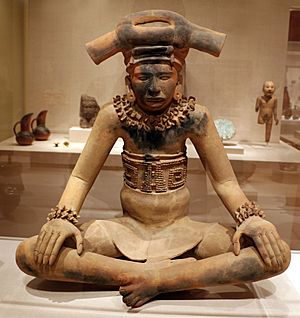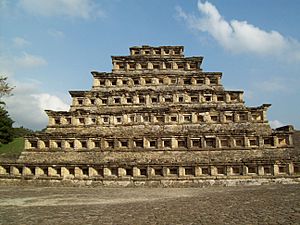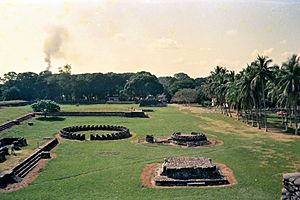Totonac culture facts for kids
The Totonac culture was a group of people who lived in ancient Mesoamerica. They were part of the Totonac people, mostly found in the areas of Veracruz and northern Puebla in Mexico. At first, they were like a group of connected cities. Later, they seemed to be organized into three main areas: North, South, and Serran (mountainous).
The Totonac people made their living through farming and trading. They built big cities like El Tajín (which was important from 300 to 1200 AD). El Tajín shows how great the Totonac culture became. Other important cities were Papantla and Cempoala, both active from 900 to 1519 AD.
These three main centers of their culture were known for their amazing art. They made many different kinds of pottery and stone sculptures. Their buildings were huge and their cities were very well planned. They were also skilled at making special stone objects like yokes, palms, and axes. They also created famous "smiley faces" and large clay sculptures.
Contents
What Does "Totonac" Mean?
The word "Totonac" comes from the Nahuatl language. It refers to people from the Totonacapan region. Some people think "totonaco" means "man of hot land."
In the Totonac language, the word is made of "tu'tu" or "a'ktu'tu," which means "three," and "nacu," meaning "heart." So, "Totonac" can mean "three hearts." This is because the Totonacs saw Cempoala, Tajín, and Castillo de Teayo as the three most important places for their group.
A Look at Totonac History
The ancient Totonac people lived in the central part of Veracruz. By the Late Classic period, their lands stretched far. They reached south to the Papaloapan River and west into parts of Oaxaca and Puebla. This whole area is known as the Totonacapan.
The Totonac culture was at its strongest during the Late Classic period. This is when they built amazing ceremonial centers. Places like El Tajín, Yohualichán, and Cempoala were built then.
In 1519, a very important meeting happened in the city of Cempoala. About 30 Totonac towns met there. This meeting changed their future and the future of many other groups in Mesoamerica. The Totonacs decided to team up with the Spanish explorer Hernán Cortés. They wanted to help him conquer Tenochtitlan, the capital of the Aztec Empire.
The Totonacs joined Cortés because they wanted to be free from the Aztec Triple Alliance. The Aztecs had taken over their lands and made them pay taxes. The Totonacs gave 1,300 warriors to Cortés, who had about 500 Spanish soldiers.
After the Aztec Empire was defeated, the Totonacs came under the control of the Spanish Empire. They were taught about Christianity and their culture slowly changed. They became workers for the Spanish, especially on sugarcane farms. Sadly, the city of Cempoala later became empty. The ancient Totonac culture was almost forgotten until the late 1800s. A Mexican historian named Francisco del Paso y Troncoso helped rediscover it.
Before the Spanish arrived, the Totonacs were part of the Tula Empire. Around 1450, the Nahuas of the Aztec Triple Alliance conquered them. The Totonacs then had to join the Aztec armies.
Today, Totonac people still live in Mexico. They are found in 26 towns in Puebla and 14 towns in Veracruz. They still speak their old language and keep many of their traditions alive.
Totonac Beliefs
Like other ancient groups in Mesoamerica, the Totonacs believed in many gods. They mostly worshipped the Sun, and sometimes offered human sacrifices to it.
They also worshipped the Goddess of Corn. She was believed to be the Sun's wife. The Corn Goddess did not like human sacrifices. Instead, people offered her animals, herbs, and flowers.
Another important god was "Old Thunder." He was the "Owner of all the waters, but not the rain." It was believed that he wanted to flood the world. People who drowned would become his servants.
Daily Life of the Totonac People
The Totonac people made their clothes from natural fibers. Totonac women traditionally wore a "huipil." This was a long, wide, embroidered dress. Many Totonac women still wear this type of dress today. Men usually wore only a loincloth.
Their homes were simple. They had one rectangular room with no separate areas inside. The furniture was basic and made of wood. The roofs were made of thatch or palm leaves. The walls were built with thick sticks.
See also
 In Spanish: Cultura totonaca para niños
In Spanish: Cultura totonaca para niños




